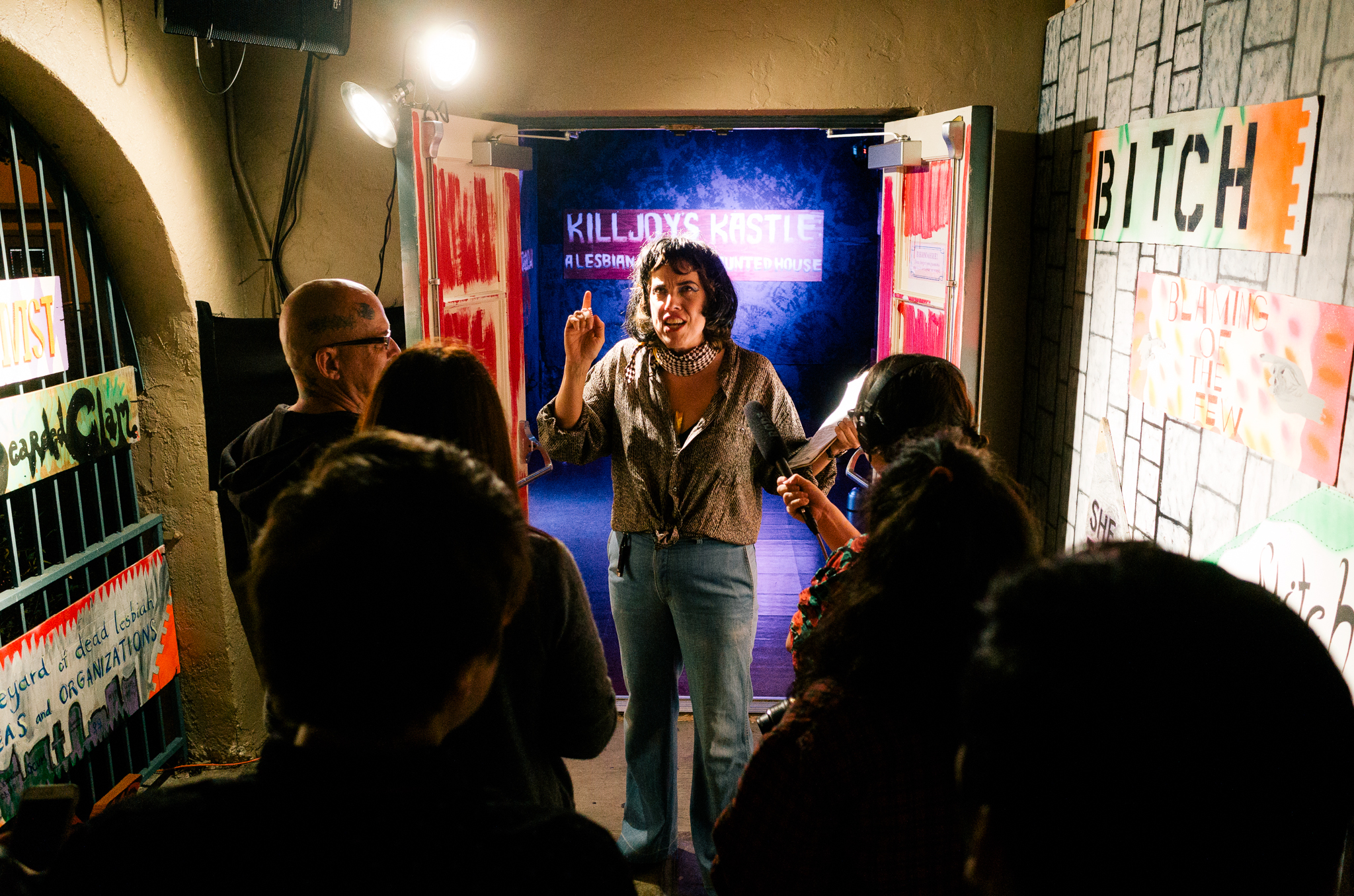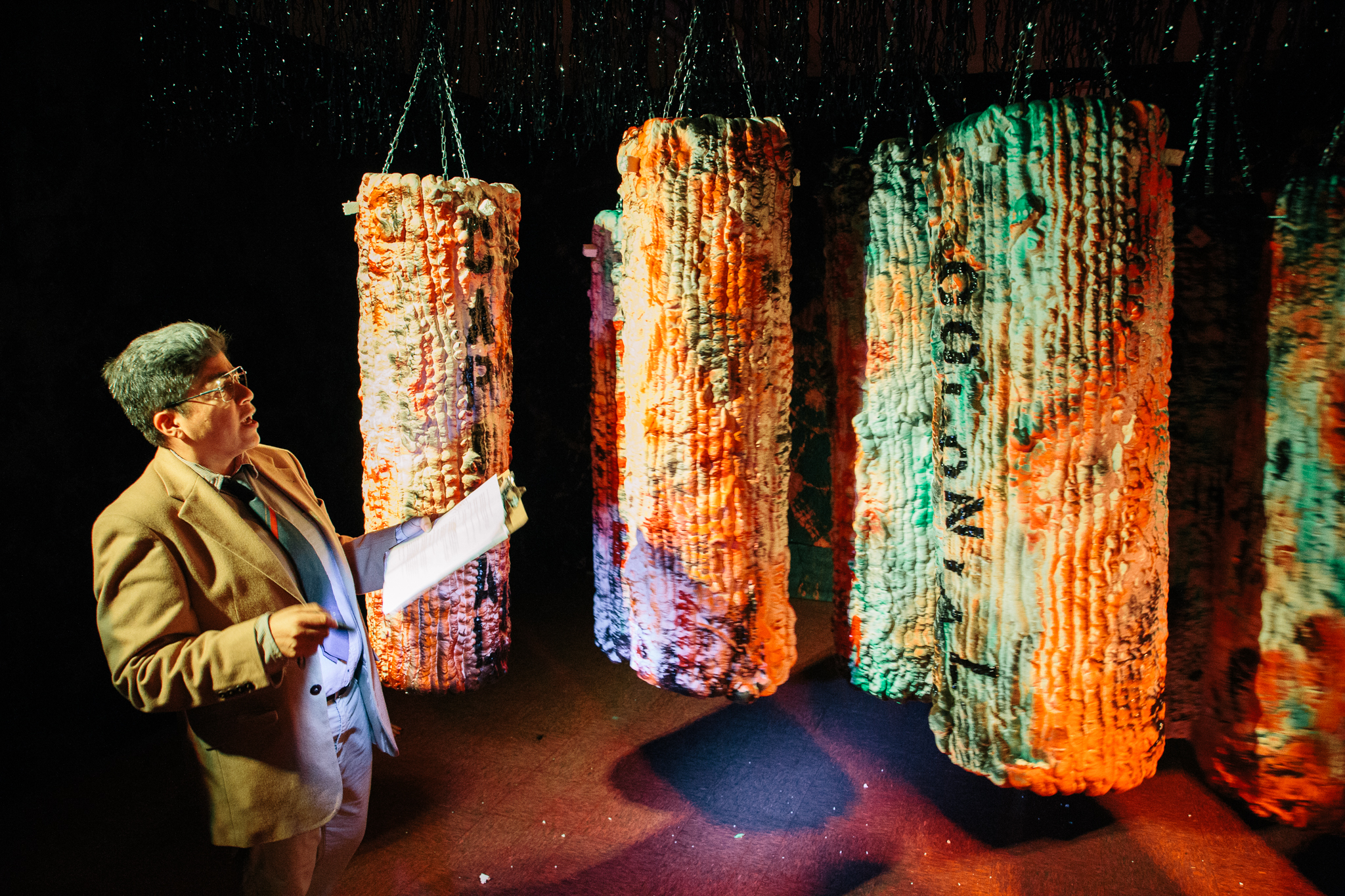At the entrance to KillJoy’s Kastle in Los Angeles, visitors are greeted by a zombie version of Valerie Solanas. Perhaps best known for her failed attempt to assassinate Andy Warhol in 1968, Solanas, an early radical feminist, was also the author of the SCUM Manifesto—or the Society for Cutting Up Men. In zombie form, Solanas lays out the rules of the haunted house with campy fervor. First and foremost: absolutely no flash cameras or flashlights. “Embrace the darkness,” she says, insisting that “the only light can come from here”—indicating her crotch, then gesturing to the sky.
More art installation than gory fright-fest, KillJoy’s Kastle is the brainchild of two Toronto-based artists, Deirdre Logue and Allyson Mitchell. The haunted house is their ode to radical lesbian feminism and the trope of the feminist killjoy—the mopy feminist shrew so often blamed for sucking the fun out of everything. KillJoy’s Kastle exaggerates such lazy stereotypes, literally demonizing their lesbian and feminist characters. Take the installation’s undead, emasculating “ball-busting butches,” or its zombified, gender studies-loving riot grrrls (or, in this case, “riot ghouls”). On the surface, it’s silly, satirical fun. But it’s also a cheeky slap in the face to the evangelical conservative right.
It’s difficult to spot the paranormal conscious raisers at first, as they crouch in the silvery glare, moaning, half-naked, inspecting their genitalia with hand-mirrors.
KillJoy’s Kastle is loosely modeled after radical evangelical haunted houses with a moralist, “come to Jesus” agenda. In a hell house, small groups are led by demon tour guides through re-enactments of the wages of society’s most deadly sins: A woman bleeding to death from a botched abortion and a funeral for a homosexual AIDS patient are two popular choices.
“In the case of the Christian hell house, they’re showing you examples of things that would send you to hell,” says Deirdre Logue. “But in our world, in a queer world, half of that is us.”
KillJoy’s Kastle favors perversion over conversion. With demon lesbians and demented women’s studies professors (one of them named “Leslie Dyke-March Assplay”) at the helm, visitors are taken through the “herstory” of radical lesbian feminism.

Upon entering the Kastle, guests are first taken to see the “Paranormal Consciousness Raisers.” This tiny lair, covered in shimmery Mylar, is immediately disorienting and unsettling. It’s difficult to spot the paranormal conscious raisers at first, as they crouch in the silvery glare, moaning, half-naked, inspecting their genitalia with hand-mirrors.
The room is meant to be jarring, Mitchell says, and to combat the stereotype of the frumpy, sex-negative feminist organizer—or of the uptight suburban housewife too afraid to look at her own vagina. The Paranormal Consciousness raisers are, in fact, quite sex-positive. They’re re-claiming the gaze of the heteropatriarchy, Mitchell says, and casting back an angry stare.
“It’s fun and it’s funny and it’s campy,” Mitchell says, “but it’s also very serious and frightening and wonder making. It’s meant to be disorienting, like you can’t look away.”
Much of Killjoy’s Kastle has a kitschy, DIY feel, an aesthetic that Logue and Mitchell have dubbed “Deep Lez.” Doorways lined with huge tufts of fur and hair become giant vaginas. Spray-painted and graffitied boxing bags morph into bloody tampons—symbols of such toxic social fixtures as transphobia, capitalism, and the patriarchy. Campy hand-painted signs line the hallway into the Kastle like advertisements at a sideshow for “Umami Meat Curtains” and a “Back Tickling and Hair Braiding Indoctrination.”

Behind all the gaudiness and sarcasm, though, much of KillJoy’s Kastle is a carefully curated nod to the radical lesbian movement of the 1970s and ’80s.
In the “Graveyard of Dead Lesbian Ideas and Organizations,” visitors are asked to take a moment of silence for keystone institutions and gathering spots, now dead and gone. Among the headstones: Vice Versa by Lisa Ben, the earliest known lesbian periodical, published in 1947 (Lisa Ben is an anagram of “lesbian”); and Little Frida’s coffee house, the well-known West Hollywood cafe featured in the 1997 episode of Ellen when Ellen Degeneres’ character comes out as a lesbian.
In the “Daddy Pen,” visitors meet two depraved prisoners, tallying their days in jail on the wall with the Venus symbol for womanhood. They pace their cell wearing unbuttoned jean vests that barely contain their breasts. Lesbian pornography is strewn about the floor. Oversexed, caged, and alone, the women of the Daddy Pen represent a time when lesbianism was ostracized in jails across the country. Throughout the 1970s and ’80s, for example, staff at the Sybil Brand Institute for Women, a Los Angeles County jail, segregated masculine-appearing or gender non-conforming women from the rest of the prison population. They were sent to Cell Block 4200, also known as the Daddy Tank, where they had fewer privileges than the rest of their fellow inmates.
At the end of most evangelical hell houses, attendees are presented with a choice between two paths: salvation in Jesus Christ, or a life of damnation. The finale of KillJoy’s Kastle, the “Processing Room,” is meant as an antithesis to that approach. Each guest, after stating their preferred gender pronoun to the group, is encouraged to share any praise, criticism, or emotional triggers that they may have experienced in the radical lesbian hell from which they’ve just emerged. It’s a gentle comedown from the cultural caricature of the Kastle, and, for some, perhaps a time to consider that being a so-called feminist killjoy may not be so bad after all—it’s empowering.
“It’s about being smart, it’s about being funny, it’s about being radically situated,” Logue says. “It’s not wrong to be a killjoy; it’s right to be a killjoy.”

Demon Week is Pacific Standard‘s series of essays exploring all things diabolical—from devils to dogs, monsters to mental illness.



